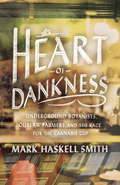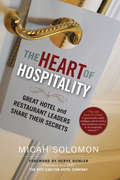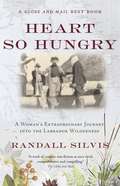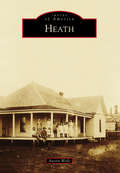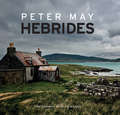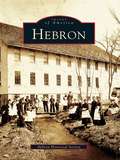- Table View
- List View
A Heart Divided: Legends of the Condor Heroes Vol. 4 (Legends of the Condor Heroes)
by Jin YongTHE CHINESE "LORD OF THE RINGS" - NOW IN ENGLISH FOR THE FIRST TIME.THE SERIES EVERY CHINESE READER HAS BEEN ENJOYING FOR DECADES - 300 MILLION COPIES SOLD."Jin Yong's work, in the Chinese-speaking world, has a cultural currency roughly equal to that of "Harry Potter" and "Star Wars" combined" Nick Frisch, New Yorker"Like every fairy tale you're ever loved, imbued with jokes and epic grandeur. Prepare to be swept along." Jamie Buxton, Daily Mail Guo Jing and Lotus have escaped Qiu Qianren's mountain stronghold on the condors' backs, but Lotus carries a wound that will surely kill her. Their only hope lies in the healing powers of Duan, the King of the South. Little do they know that to seek an audience with this mysterious figure will place him in mortal danger himself. Meanwhile, many li away on Peach Blossom Island, a plan has been hatched that could tear the two lovers apart for good. And, with Moon Festival approaching, Guo Jing is honour bound to take part in a long-awaited martial contest at the Tower of Mist and Rain in Jiaxing. Yet the greatest threat to their happiness stems from Guo Jing's past. He is still betrothed to Genghis Khan's daughter. Rejoining the Mongol army could help him to avenge his father - but it may force him to take the field against the soldiers of his true homeland, splitting his heart and soul in two. Translated from the Chinese by Gigi Chang and Shelly Bryant
Heart of Dankness
by Mark Haskell SmithReporting for the Los Angeles Times on the international blind tasting competition held annually in Amsterdam known as the Cannabis Cup, novelist Mark Haskell Smith sampled a variety of marijuana that was unlike anything he'd experienced. It wasn't anything like typical stoner weed, in fact it didn't get you stoned. This cannabis possessed an ephemeral quality known to aficionados as "dankness." Armed with a State of California Medical Marijuana recommendation, he begins a journey into the international underground where super-high-grade marijuana is developed and tracks down the rag-tag community of underground botanists, outlaw farmers, and renegade strain hunters who pursue excellence and diversity in marijuana, defying the law to find new flavors, tastes, and effects. This unrelenting pursuit of dankness climaxes at the Cannabis Cup, which Haskell Smith vividly portrays as the Super Bowl/Mardi Gras of the world's largest cash crop.From the Trade Paperback edition.
The Heart of Hospitality: Great Hotel and Restaurant Leaders Share Their Secrets
by Micah Solomon Herve HumlerSuccess in today's rapidly changing hospitality industry depends on understanding the desires of guests of all ages, from seniors and boomers to the newly dominant millennial generation of travelers. Help has arrived with a compulsively-readable new standard, The Heart of Hospitality: Great Hotel and Restaurant Leaders Share Their Secrets by Micah Solomon, with a foreword by The Ritz-Carlton Hotel Company's president and COO Herve Humler.This up-to-the-minute resource delivers the closely guarded customer experience secrets and on-trend customer service insights of today's top hoteliers, restaurateurs, and masters of hospitality management including:Four Seasons Chairman Isadore Sharp: How to build an unsinkable company cultureUnion Square Hospitality Group CEO Danny Meyer: His secrets of hiring, onboarding, training, and moreTom Colicchio (Craft Restaurants, Top Chef): How to create a customer-centric customer experience in a chef-centric restaurantVirgin Hotels CEO Raul Leal: How Virgin Hotels created its innovative, future-friendly hospitality approachRitz-Carlton President and COO Herve Humler: How to engage today's new breed of luxury travelers Double-five-star chef and hotelier Patrick O'Connell (The Inn at Little Washington) shares the secrets of creating hospitality connectionsDesigner David Rockwell on the secrets of building millennial-friendly restaurants and hotel spaces (W, Nobu, Andaz) that resonate with today's travelersRestaurateur Traci Des Jardins on building a "narcissism-free" hospitality cultureLegendary chef Eric Ripert's principles of creating a great guest experiences, simultaneously within a single dining room.The Heart of Hospitality is a hospitality management resource like no other, put together by leading customer service expert Micah Solomon. Filled with exclusive, first-hand stories and wisdom from the top professionals in the industry, The Heart of Hospitality is an essential hospitality industry resource.As Ritz-Carlton President and COO Herve Humler says in his foreword to the book, "If you want to create and sustain a level of service so memorable that it becomes an unbeatable competitive advantage, you'll find the secrets here."
The Heart of Man
by Jón Kalman StefánssonAfter coming through the blizzard that almost cost them everything, Jens and the boy are far from home, in a fishing community at the edge of the world. Taken in by the village doctor, the boy once again has the sense of being brought back from the grave. But this is a strange place, with otherworldly inhabitants, including flame-haired Álfheiður, who makes him wonder whether it is possible to love two women at once; he had believed his heart was lost to Ragnheiður, the daughter of the wealthy merchant in the village to which he must now inexorably return. Set in the awe-inspiring wilderness of the extreme north, The Heart of Man is a profound exploration of life, love and desire, written with a sublime simplicity. In this conclusion to an audacious trilogy, Stefánsson brings a poet's eye and a philosopher's insight to a tale worthy of the sagasmiths of old.
The Heart of Man
by Jón Kalman StefánssonAfter coming through the blizzard that almost cost them everything, Jens and the boy are far from home, in a fishing community at the edge of the world. Taken in by the village doctor, the boy once again has the sense of being brought back from the grave. But this is a strange place, with otherworldly inhabitants, including flame-haired Álfheiður, who makes him wonder whether it is possible to love two women at once; he had believed his heart was lost to Ragnheiður, the daughter of the wealthy merchant in the village to which he must now inexorably return. Set in the awe-inspiring wilderness of the extreme north, The Heart of Man is a profound exploration of life, love and desire, written with a sublime simplicity. In this conclusion to an audacious trilogy, Stefánsson brings a poet's eye and a philosopher's insight to a tale worthy of the sagasmiths of old.
The Heart of the Matter: Questions to Ask Your Cardiologist
by Douglas Westveer Sandra JordanIf you're browsing through The Heart of the Matter, the threat of cardiac disease is lurking in your mind, and with good reason. Although national programs to contain this killer are highly successful and ahead of schedule, heart disease remains highly prevalent and deadly. Medical research during the last 15 years has successfully defined many treatment strategies that work, and many that don't. Your task is not to understand this mountain of information, but to know the critical questions to ask your doctor when you are in trouble. The Heart of the Matter will highlight for you the right questions to ask after your heart attack, or if you're afflicted by hypertension, high cholesterol, or heart failure. Before you need a pacemaker, defibrillator, heart surgery, or angioplasty, the right questions need to be asked, and you'll find out why they're important. Take advantage of all of the recent research and years of clinical experience by the authors in managing heart disease.
Heart So Hungry: A Woman's Extraordinary Journey into the Labrador Wilderness
by Randall SilvisA gripping cold weather, true-life adventure, Heart So Hungry tells the story of a race across Labrador and one woman's determination -- inspired by grief and fed by outrage -- to set the record straight. A remarkable adventure, a love story and a thrilling race are all front and centre in this account of how one woman's devotion to her late husband's memory transformed Mina Hubbard from a rural Ontario nurse into the most celebrated female explorer of her time. In 1903, following an ambitious expedition to map the interior of Labrador, Mina's husband, Leonidas, dies of starvation in a cold, boggy, wind-scoured landscape. Allegations surface that the expedition failed because of Hubbard's incompetence, so Dillon Wallace, Leonidas' partner on the failed expedition, decides to honour a promise that he made to Hubbard to complete the route that they had been supposed to take. When Mina Hubbard discovers what Wallace has planned, she doubts his motives and decides to mount her own Labrador expedition and to beat Wallace to the finish line. Driven by her devotion, Mina wins the race, beating Wallace by a month and a half, and becomes in the process the first white woman to make contact with the elusive Naskapis Indians. Using original, unpublished source material, as well as books written by the main actors in the drama, novelist Randall Silvis pieces together a narrative of the race between Wallace and Mina Hubbard, as well as the fateful first expedition of Wallace and Leonidas Hubbard.
Heartland Habitats: 265 Midwest Nature Walks
by Mary BlocksmaStar-shaped flowers, short-tempered snapping turtles, and clusters of chicken-flavored mushrooms are just a few of the many fascinating things awaiting discovery just beyond the typical North American backyard.In Heartland Habitats: 265 Midwest Nature Walks, Mary Blocksma guides readers through North American terrain, introducing them to the land and its thriving wildlife of Minnesota, Iowa, Missouri, Wisconsin, Illinois, Michigan, Indiana, and Ohio. From birds of all kinds to fungi of both the tasty and deadly varieties—Chicken of the Woods, Death Caps, Jack-O-Lanterns—Blocksma gradually uncovers a world rich with breathtaking beauty. Adventures filled with swan-on-goose battles, squirrel squabbles, and forays into forests all lead to a deeper understanding of the world around us.A lively and detailed guide in befriending the great outdoors, Heartland Habitats showcases the natural wonders thriving just outside our homes with full-color illustrations and vivid descriptions.
The Heartless Stone: A Journey Through the World of Diamonds, Deceit, and Desire
by Tom ZoellnerAn American Library Association Notable Book. When he proposed to his girlfriend, Tom Zoellner gave what is expected of every American man--a diamond engagement ring. But when the relationship broke apart, he was left with a used diamond that began to haunt him. His obsession carried him around the globe; from the "blood diamond" rings of Africa; to the sweltering polishing factories of India; to mines above the Arctic Circ to illegal diggings in Brazil; to the London headquarters of De Beers, the secretive global colossus that has dominated the industry for more than a century and permanently carved the phrase "A diamond is forever" on the psyche. An adventure story in the tradition of Susan Orlean's The Orchid Thief, The Heartless Stone is a voyage into the cold heart of the world's most unyielding gem.
The Heartless Stone: A Journey Through the World of Diamonds, Deceit, and Desire
by Tom ZoellnerIn 2000, Tom Zoellner purchased a diamond engagement ring and proposed. His girlfriend said, "yes" and then, suddenly, walked out of his life making Tom the owner of a used engagement ring. Instead of hitting the self-help shelves of his local bookstore, he hit the road travelling to diamond mines in Africa, Canada, India, Brazil and Russia to discover the true worth of this shining gem. He travelled to Japan to understand how diamonds were linked with engagements and delved into the history of our own American romance with the diamond ring. He gained entry to DeBeers, the London diamond merchants. He visited shopping mall jewellers with starry-eyed couples. Through all of his travels, he searched for an answer to the question "How has one stone created empires, ruined lives, inspired lust and emptied wallets throughout history?" A diamond version of Susan Orleans's The Orchid Thief, Tom Zoellner's The Heartless Stone is a journey to the cold heart of the world's most unyielding gem.
Heartsinger
by Karlijn Stoffels Laura WatkinsonIn this meditation on various kinds of love, Mee travels across the country to the court of the Princess Esperanza, singing the life stories of some of the people he meets.
Heath (Images of America)
by Austin WellsWhen John O. Heath first settled in the area now known as Heath in 1848, wild turkey and deer were as plentiful as the area's timber and rich, black soil. The fertile land and convenient location along the east fork of the Trinity River prompted several settlers to follow the Heath family's lead, and Heath experienced steady growth in the early 1900s, with several businesses and schools in operation. Life was hard in those days, with food and money hard to come by, but locals found sanctuary in social gatherings, endless games of 42, mink hunting in the winter, and baseball. Heath's economy was given a big lift when the lake adjacent to the community, known as Lake Ray Hubbard, was filled in 1969 after a seemingly endless rain. With the attraction of the lake and developments that stemmed from it, such as the Rush Creek Yacht Club, Heath now faces the challenge of maintaining steady growth while continuing to stick to its roots as a charming, tight-knit community with an open countryside atmosphere.
Heaven and Earth
by Paolo Giordano'A devastating marvel of a novel' Sunday Telegraph 'A highly enjoyable novel... Giordano is especially good on the textures, smells, heat and colours of the Italian south. These stay long in the mind, as does the way he writes about the obsessiveness of love, the way it dominates and distorts and the self-delusions and fantasies it gives rise to' TLS 'If you're pining for an Italian break, then this might be the remedy: Heaven And Earth is rooted so deep in idyllic Puglia that you can almost feel the red soil under your sandals' Daily Mail 'Raw and evocative: a breathtaking and poignant creation that will leave you itching under the skin' Herald 'A stunning achievement' André Aciman, author of Call Me By Your Name 'Perfect, moving, honest, brilliant, with characters who feel like old friends' Andrew Sean Greer, Pulitzer Prize-winning author of Less 'The perfect novel. Paolo Giordano is one of the handful of great writers working anywhere today' Edmund White Every summer Teresa follows her father to his childhood home in Puglia, down in the heel of Italy, a land of relentless, shimmering heat, centuries-old olive groves and taciturn, proud people. There Teresa spends long afternoons enveloped in a sun-struck stupor, reading her grandmother's cheap crime paperbacks.Everything changes the summer she meets the three boys who live on the masseria next door: Nicola, Tommaso and Bern - the man Teresa will love for the rest of her life. Raised like brothers on a farm that feels to Teresa almost suspended in time, the three boys share a complex, intimate and seemingly unassailable bond. But no bond is unbreakable and no summer truly endless, as Teresa soon discovers. Because there is resentment underneath the surface of that strange brotherhood, a twisted kind of love that protects a dark secret. And when Bern - the enigmatic, restless gravitational centre of the group - commits a brutal act of revenge, not even a final pilgrimage to the edge of the world will be enough to bring back those perfect, golden hours in the shadow of the olive trees.PRAISE FOR PAOLO GIORDANO 'Mesmerizing... Giordano works with piercing subtlety' New York Times'Elegant and fiercely intelligent' Elle'Elegiac, tender and mournful' Wall Street Journal
Heaven and Hell
by Jón Kalman StefánssonIn a remote part of Iceland, a boy and his friend Barður join a boat to fish for cod. A winter storm surprises them out at sea and Barður, who has forgotten his waterproof as he was too absorbed in 'Paradise Lost', succumbs to the ferocious cold and dies. Appalled by the death and by the fishermen's callous ability to set about gutting the fatal catch, the boy leaves the village, intending to return the book to its owner. The extreme hardship and danger of the journey is of little consequence to him - he has already resolved to join his friend in death. But once in the town he immerses himself in the stories and lives of its inhabitants, and decides that he cannot be with his friend just yet. Set at the turn of the twentieth century, Heaven and Hell is a perfectly formed, vivid and timeless story, lyrical in style, and as intense a reading experience as the forces of the Icelandic landscape themselves. An outstandingly moving novel.
Heaven and Hell
by Jón Kalman StefánssonIn a remote part of Iceland, a boy and his friend Barður join a boat to fish for cod. A winter storm surprises them out at sea and Barður, who has forgotten his waterproof as he was too absorbed in 'Paradise Lost', succumbs to the ferocious cold and dies. Appalled by the death and by the fishermen's callous ability to set about gutting the fatal catch, the boy leaves the village, intending to return the book to its owner. The extreme hardship and danger of the journey is of little consequence to him - he has already resolved to join his friend in death. But once in the town he immerses himself in the stories and lives of its inhabitants, and decides that he cannot be with his friend just yet. Set at the turn of the twentieth century, Heaven and Hell is a perfectly formed, vivid and timeless story, lyrical in style, and as intense a reading experience as the forces of the Icelandic landscape themselves. An outstandingly moving novel.
Heavenly Bodies: Cult Treasures And Spectacular Saints From The Catacombs
by Paul KoudounarisDeath has never looked so beautiful. The fully articulated skeleton of a female saint, dressed in an intricate costume of silk brocade and gold lace, withered fingers glittering with colorful rubies, emeralds, and pearls—this is only one of the specially photographed relics featured in Heavenly Bodies.In 1578 news came of the discovery in Rome of a labyrinth of underground tombs, which were thought to hold the remains of thousands of early Christian martyrs. <P><P>Skeletons of these supposed saints were subsequently sent to Catholic churches and religious houses in German-speaking Europe to replace holy relics that had been destroyed in the wake of the Protestant Reformation. The skeletons, known as “the catacomb saints,” were carefully reassembled, richly dressed in fantastic costumes, wigs, crowns, jewels, and armor, and posed in elaborate displays inside churches and shrines as reminders to the faithful of the heavenly treasures that awaited them after death. <P><P>Paul Koudounaris gained unprecedented access to religious institutions to reveal these fascinating historical artifacts. Hidden for over a century as Western attitudes toward both the worship of holy relics and death itself changed, some of these ornamented skeletons appear in publication here for the first time.
The Heavenly Ice Cream Shop: 'Possibly the best book I have ever read' Amazon reviewer
by Abby ClementsFor fans of Meet Me at Beachcomber Bay - a wonderful feel-good read from the author of Meet Me Under the Mistletoe.When Imogen and Anna unexpectedly inherit their grandmother Vivien's ice cream parlour, it turns both their lives upside-down. The Brighton shop is a seafront institution, but while it's big on charm it's critically low on customers. If the sisters don't turn things around quickly, their grandmother's legacy will disappear forever...Discover this feel-good bestseller set by the sea, perfect for fans of Jenny Oliver and Fiona Gibson. What readers are saying about Abby Clements: 'Deliciously romantic. A perfect summer read!' Miranda Dickinson'This sunshine tale of friendship, family and 99 Flakes was a pure delight from start to finish...Loved it' Victoria Fox'A summer read that is as heavenly as ice cream and leaves you hungry for more!' I Heart Books'Possibly the best book I have ever read.' Amazon reviewer
The Heavenly Ice Cream Shop: 'Possibly the best book I have ever read' Amazon reviewer
by Abby ClementsFor fans of Meet Me at Beachcomber Bay - a wonderful feel-good read from the author of Meet Me Under the Mistletoe.When Imogen and Anna unexpectedly inherit their grandmother Vivien's ice cream parlour, it turns both their lives upside-down. The Brighton shop is a seafront institution, but while it's big on charm it's critically low on customers. If the sisters don't turn things around quickly, their grandmother's legacy will disappear forever...Discover this feel-good bestseller set by the sea, perfect for fans of Jenny Oliver and Fiona Gibson.What readers are saying about Abby Clements: 'Deliciously romantic. A perfect summer read!' Miranda Dickinson'This sunshine tale of friendship, family and 99 Flakes was a pure delight from start to finish...Loved it' Victoria Fox'A summer read that is as heavenly as ice cream and leaves you hungry for more!' I Heart Books'Possibly the best book I have ever read.' Amazon reviewer
Hebridean Journey: The Magic of Scotland's Outer Isles
by Brigid BensonShortlisted for the Scottish Nature Photography Book Awards Washed by the surging waves of the Atlantic Ocean, the island chain of Scotland's Outer Hebrides lies at the very edge of Europe. From white shell sands, peaty moors and gnarly mountains to heather hills, sea-green lochs and mysterious ancient monuments, these are places of unrivalled beauty. This book is a fabulous invitation to discover the unique magic of Lewis and Harris, Berneray, North Uist, Grimsay, Benbecula, South Uist, Eriskay, Bara and Vatersay, as well as the vibrant Gaelic culture of the islanders. Packed with fascinating insights, hidden gems and helpful information, it offers the uplifting opportunity for meaningful travels and life-affirming experiences in these extraordinary islands.
Hebrides
by Peter May David WilsonSince the publication of The Blackhouse in 2011, the books of Peter May's groundbreaking Lewis Trilogy have enthralled millions of readers around the world with powerfully evocative descriptions of the Outer Hebrides.From its peat bogs and heather-coated hills, from its weather-beaten churches and crofters cottages to its cold clear rills choked with rainwater, the islands off the northwest coast of Scotland have been brought to vivid life by this accomplished novelist.Now, Peter May and photographer David Wilson present a photographic record of the countless locations around the Hebridean archipelago that so inspired May when he was bringing the islands of detective Fin McLeod's childhood to the page. From the tiny southern island of Barra to the largest and most northern island of Lewis, travel the storm-whipped North Atlantic scenery with May as he once again strolls the wild and breathtaking countryside that gave birth to his masterful trilogy of novels.
Hebron
by Hebron Historical SocietySettled in 1704 and incorporated in 1708, Hebron is one of the oldest towns in Connecticut. Predominantly a farming community for generations, Hebron is also the home of many famous people. Hebron contains pictures of Governor John Peters, Dr. Charles Douglas, author Annie Hutchinson Foote, poet Susan Pendleton, the musically gifted Tennant family, Hebron's turn-of-the-century baseball team, and the Porters, the Hills, the Hildings, and many other lifelong Hebron residents. Hebron was also an industrial center with its own Ams-Sterling automobile, a busy train depot that connected travelers with New York and Boston, silk mills, and cottage industries. This book is the first pictorial history of Hebron ever published and contains many rare photographs from private collections.
Heida: A Shepherd at the Edge of the World
by Steinunn Sigurðardóttir'HEIDA IS A FORCE OF NATURE . . . EXACTLY THE RIGHT SORT OF MODERN ROLE MODEL' SUNDAY TIMESThe inspiring story of Icelandic sheep farmer, former model and feminist heroine Heida Asgeirsdottir has become a double prize-winning international bestseller.As heard on Radio 4's Start the WeekI'm not on my own because I've been sitting crying into a handkerchief or apron over a lack of interested men. I've been made every offer imaginable over the years. Men offer themselves, their sons . . . drunk fathers sometimes call me up and say things like: "Do you need a farmhand?" "I can lift the hay bales" "I can repair your tractors". . .Heida is a solitary farmer with a flock of 500 sheep in a remorseless area bordering Iceland's highlands. It's known as the End of the World. One of her nearest neighbours is Iceland's most notorious volcano, Katla, which has periodically driven away the inhabitants of Ljótarstaðir ever since people first started farming there in the twelfth century. This portrait of Heida written with wit and humour by one of Iceland's most acclaimed novelists, Steinunn Sigurðardóttir, tells a heroic tale of a charismatic young woman, who walked away from a career as a model to take over the family farm at the age of 23. I want to tell women they can do anything, and to show that sheep farming isn't just a man's game. Divided into four seasons, Heida tells the story of a remarkable year, when Heida reluctantly went into politics to fight plans to raise a hydro-electric power station on her land. This book paints a unforgettable portrait of a remote life close to nature. Translated into six languages, Heida has won two non-fiction prizes and has become an international bestseller.We humans are mortal; the land outlives us, new people come, new sheep, new birds and so on but the land with its rivers and lakes and resources, remains.'UTTERLY CHARMING' MAIL ON SUNDAY'REVELATORY AND INSPIRING' HERALD
Heida: A Shepherd at the Edge of the World
by Steinunn Sigurðardóttir'HEIDA IS A FORCE OF NATURE . . . EXACTLY THE RIGHT SORT OF MODERN ROLE MODEL' SUNDAY TIMESThe inspiring story of Icelandic sheep farmer, former model and feminist heroine Heida Asgeirsdottir has become a double prize-winning international bestseller.As heard on Radio 4's Start the WeekI'm not on my own because I've been sitting crying into a handkerchief or apron over a lack of interested men. I've been made every offer imaginable over the years. Men offer themselves, their sons . . . drunk fathers sometimes call me up and say things like: "Do you need a farmhand?" "I can lift the hay bales" "I can repair your tractors". . .Heida is a solitary farmer with a flock of 500 sheep in a remorseless area bordering Iceland's highlands. It's known as the End of the World. One of her nearest neighbours is Iceland's most notorious volcano, Katla, which has periodically driven away the inhabitants of Ljótarsta?ir ever since people first started farming there in the twelfth century. This portrait of Heida written with wit and humour by one of Iceland's most acclaimed novelists, Steinunn Sigur?ardóttir, tells a heroic tale of a charismatic young woman, who walked away from a career as a model to take over the family farm at the age of 23. I want to tell women they can do anything, and to show that sheep farming isn't just a man's game. Divided into four seasons, Heida tells the story of a remarkable year, when Heida reluctantly went into politics to fight plans to raise a hydro-electric power station on her land. This book paints a unforgettable portrait of a remote life close to nature. Translated into six languages, Heida has won two non-fiction prizes and has become an international bestseller.We humans are mortal; the land outlives us, new people come, new sheep, new birds and so on but the land with its rivers and lakes and resources, remains.'UTTERLY CHARMING' MAIL ON SUNDAY'REVELATORY AND INSPIRING' HERALD
Heida: A Shepherd at the Edge of the World
by Steinunn SigurðardóttirThe inspiring story of Icelandic sheep farmer, former model and feminist heroine has become an international bestseller and won both the Icelandic Booksellers' Prize and Women's Literature Prize.I'm not on my own because I've been sitting crying into a handkerchief or apron over a lack of interested men. I've been made every offer imaginable over the years. Men offer themselves, their sons...drunk fathers sometimes call me up and say things like: "Do you need a farmhand?" "I can lift the hay bales" "I can repair your tractors"...Heiða is a solitary farmer with a flock of 500 sheep in a remorseless area bordering Iceland's highlands. It's known as the End of the World. One of her nearest neighbours is Iceland's most notorious volcano, Katla, which has periodically driven away the inhabitants of Ljótarstaðir ever since people first started farming there in the twelfth century. This portrait of Heiða written with wit and humour by one of Iceland's most acclaimed novelists, Steinunn Sigurðardóttir, tells a heroic tale of a charismatic young woman, who at 23 walked away from a career as a model in New York to take over the family farm when her father died. I want to tell women they can do anything, and to show that sheep farming isn't just a man's game. I guess I've always been a feminist. When I was growing up, there was a female president, and I used to wear the same clothes and play with the same toys as the boys. It was just normal to me.Divided into four seasons, Heiða tells the story of a remarkable year, interwoven with vivid stories of her animals and farm work and paints a unforgettable portrait of a remote life close to nature.We humans are mortal; the land outlives us, new people come, new sheep, new birds and so on but the land with its rivers and lakes and resources, remains.(P)2019 Hodder & Stoughton Limited
Heidi Across America: One Woman's Journey on a Bicycle Through the Heartland
by Heidi BeierleA memoir of homecoming – Heidi Across America is a gritty story of how opening our hearts to others enables us to open our hearts to ourselves and love what we find there.In the summer of 2010, Heidi Beierle had just finished her first year of graduate studies in community and regional planning and decided to pedal her bicycle solo from her home on the west coast across rural America to the Preserving the Historic Road conference in Washington, D.C. What started as a research trip turned into an intimately physical and psychological encounter with self and nationhood. Heidi was 35 at the time and didn&’t love much about herself except her ability to endure grueling physical undertakings. She viewed her journey as an opportunity to fix her failures and insufficiencies. There were also some research questions she wanted to explore: Why do people live in small towns and what do they like about it? Did a bicyclist like herself bring economic benefit to the small towns she visited? What could communities do to support or invite cyclists to stay in their towns? What could cyclists do to support the communities? Along the way, she was surprised by the kindness of strangers and the emotional pinch of traveling through Wyoming where she grew up. Her journey led her through the Plains and into the Ozarks where the heat climbed to agonizing temperatures and every pedal stroke in the heat felt one closer to death. By the time she completed the trip, Heidi discovered a newfound compassion for herself and a growing love for her country. Strangers opened their hearts to her and in turn, she opened her heart to herself. And her questions began to change and mirror things many Americans are asking themselves today: How can I be okay in my own skin? What does it mean to be enough? How do I satisfy my desire to travel without harming the planet? What does it mean to love America? For many young people, it is a rite of passage to light out on an adventure to see the world and expose themselves to new experiences, but we don&’t often talk about how Americans seeing America can open us to the diversity, awe, and wonder available right here in our nation. Heidi Across America offers a journey to self-love, empathy, consideration for others, and respect for the spirit of place as pathways to find connection and home.

